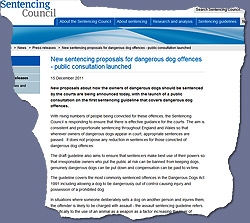Harsher Sentencing Guidelines Issued To Judges In Dangerous Dogs Cases
New proposals about how the owners of dangerous dogs should be sentenced by the courts are being announced today, with the launch of a public consultation on the first sentencing guideline that covers dangerous dog offences.
 With rising numbers of people being convicted for these offences, the Sentencing Council is responding to ensure that there is effective guidance for the courts. The aim is consistent and proportionate sentencing throughout England and Wales so that wherever owners of dangerous dogs appear in court, appropriate sentences are passed. It does not propose any reduction in sentences for those convicted of dangerous dog offences.
With rising numbers of people being convicted for these offences, the Sentencing Council is responding to ensure that there is effective guidance for the courts. The aim is consistent and proportionate sentencing throughout England and Wales so that wherever owners of dangerous dogs appear in court, appropriate sentences are passed. It does not propose any reduction in sentences for those convicted of dangerous dog offences.
Almost 1,200 people were sentenced for offences that would be covered by the new guidelines last year, up 35% from 855 offences in 2009, the council said.
This must of course not be seen in isolation of the years of campaiging being done by the CWU through its "Bite-Back" Campaign seeking the government to fulfill it's promises made when in opposition, to introduce tougher legislation concerning dangerous dog.
Following a meeting with Lord Taylor on 15th November, Dave Joyce, CWU's Health Safety and Environment National Officer wrote to him on 28th November welcoming the promise made at the meeting to review current sentencing guidelines:
"I welcome the plans for referral to the Sentencing Advisory Council, the question of appropriate sentencing and punishment in Dog Attack cases, as despite the range of sentences available, the Courts have traditionally treated dog attack offences far to leniently."
Dave's letter also covered several key areas such as the compulsory micro-chipping of dogs, extension of current legislation to attacks by dogs on private property, and the consolidation of existing dangerous dogs law into a combined single piece of legilsation.
In the meantime, the guidelines announced for consultation covers the most commonly sentenced offences in the Dangerous Dogs Act 1991 including allowing a dog to be dangerously out of control causing injury and possession of a prohibited dog.
 In situations where someone deliberately sets a dog on another person and injures them, the offender is likely to be charged with assault - the assault sentencing guideline refers specifically to the use of an animal as a weapon as a factor increasing the level of sentence.
In situations where someone deliberately sets a dog on another person and injures them, the offender is likely to be charged with assault - the assault sentencing guideline refers specifically to the use of an animal as a weapon as a factor increasing the level of sentence.
The Council’s proposals take into account findings from research it conducted to explore the public’s views on sentencing for these offences and the guideline ranges largely reflect sentences suggested by the majority of respondents. The consultation now gives the opportunity for anyone to give their views on the proposals.
Anne Arnold, district judge and member of the Sentencing Council, said:
“The majority of dog owners take good care of their pets and keep their dogs under control but we want to ensure that irresponsible dog owners who put the public at risk are sentenced appropriately. Our guideline gives guidance to courts on making the best use of their powers so that people can be banned from keeping dogs, genuinely dangerous dogs can be put down and compensation can be paid to victims.
“This consultation provides an opportunity for anyone interested in this issue to give their views so we can make sure the guidelines are as effective as possible.”
Trevor Cooper, dog law expert and dog law consultant for Dogs Trust, the UK’s largest dog welfare charity, commented:
“Courts often face the difficult task of deciding on appropriate sentencing in dog cases, which can be emotive and complex. These draft guidelines on dangerous dog offences will help to provide much needed clarity and consistency in assessing individual cases and this consultation will be considered with due diligence. This also presents a timely opportunity for dog owners to proffer their own views on this consultation and play a part in helping to shape the sentencing procedure.”
A consultation paper, resource assessment, equality impact assessment, statistical bulletin, research bulletin and an online questionnaire are available during this consultation period.
These can be found here on the Sentencing Council's website
The consultation closes on 8 March 2012 and all responses to the consultation should be sent to arrive by then. Full details of submitting the repsonses are on the Sentencing Council's website
The draft guideline covers six dangerous dog offences in the Dangerous Dogs Act 1991:
- owner or person in charge of a dog which was dangerously out of control in a public place injuring any person;
- owner or person in charge allowing a dog to be in a private place where the dog is not permitted to be injuring any person;
- owner or person in charge of a dog which was dangerously out of control in a public place;
- owner or person in charge allowing a dog to be in a private place where the dog not permitted to be;
- possession of a prohibited dog (these are the Pit Bull Terrier, Japanese tosa, Dogo Argentino and Fila Brasileiro); and
- breeding, selling or exchanging a prohibited dog.
Guidelines set sentencing ranges within current legislation. When legislation changes, guidelines are amended as appropriate.
The full Sentencing Council's consultation documents can be downloaded from their website
You can donwload Dave Joyce's letter to Lord Taylor here
See also: MPs Back Call For Dog Law Reform on the CWU national website
Source: Sentencing Council / Express on line / CWU



 In situations where someone deliberately sets a dog on another person and injures them, the offender is likely to be charged with assault - the assault sentencing guideline refers specifically to the use of an animal as a weapon as a factor increasing the level of sentence.
In situations where someone deliberately sets a dog on another person and injures them, the offender is likely to be charged with assault - the assault sentencing guideline refers specifically to the use of an animal as a weapon as a factor increasing the level of sentence.